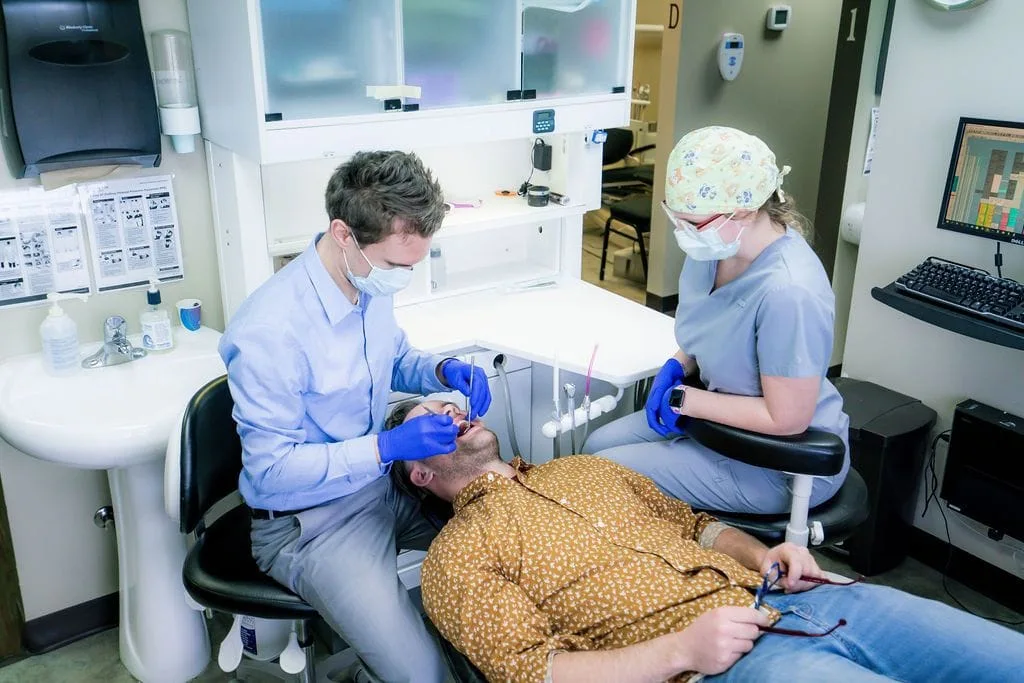Emergency Dental Tips

Toothache
First call your dentist. Explain your symptoms and ask to be seen as soon as possible. Then ease the pain. Take an over-the-counter pain medicine that works for you, but do not put the pills on your sore tooth. Hold an ice pack against your face at the spot of the sore tooth. Do not put a heating pad, a hot water bottle, or any other source of heat on your jaw. Heat will make things worse instead of better.
Chipped or broken tooth
Broken teeth can almost always be saved. Call your dentist and explain what happened. He or she will see you right away. If it’s a small break, your dentist may use a white filling to fix the tooth. If the break is serious, a root canal may be needed. Your tooth may also need a crown (also called a cap).
Knocked out tooth
If the knocked-out tooth is an adult (or permanent) tooth, your dentist may be able to put it back. You must act quickly. If the tooth is put back in place within 10 minutes, it has a fair chance of taking root again. After 2 hours, the chances are poor. If the tooth looks clean, put it back in its place (its socket). If this is not possible, or if there’s a chance that the tooth might be swallowed, put it in a container of cold milk. Go to your dentist, or to the nearest dentist, right away. If you get help within ten minutes, there is a fair chance that the tooth will take root again.
Badly bitten lip or tongue
If there is bleeding, press down on the part of the mouth that is bleeding. Use a clean cloth to do this. If the lip is swollen, use an ice pack to keep the swelling down. If the bleeding does not stop, go to Emergency at a hospital right away.
Something stuck between teeth
First, try using dental floss, very gently and carefully, to remove the object. Never poke between your teeth with a pin or similar sharp, pointy object; it can cut your gums or scratch the tooth surface. If you can’t get the object out, see your dentist.
Lost filling
Put a piece of softened sugarless chewing gum in the spot where the filling was lost. This will protect the area for a short period of time. See a dentist as soon as possible.
(Emergency Tips excerpted from the Canadian Dental Association)
If you have a dental emergency, please contact us today.
FAQs
Sensitive teeth often come from the fact that your gums have slightly receded. This recession of the gum line allows the underlying dentin to show through which allows water and food easier access to the sensitive nerve. To manage this, there are a number of toothpastes, gels and even some dental procedures that can be applied. Speak to us in more detail if you have very sensitive teeth.
Great teeth and gum care start at home. Brushing and flossing on a daily basis is the best way to take care of your teeth and gums on a continual basis. By keeping to a daily routine you will greatly minimize the risk of gingivitis or tooth decay as you age.
Gingivitis is a condition caused when bacteria surrounds the teeth and enters the gums. The gums can become irritated, inflamed and often bleed. In order to prevent the condition from worsening, regular hygiene visits are highly recommended. During your visit, our Hygiene team will teach you the proper flossing techniques and Oral Hygiene protocol for Home Care will prevent the Periodontal Disease.
Periodontal Disease is a quiet disease that begins with little or no symptoms. It is caused by bacteria that surrounds the teeth and enters the gums. The immediate condition is known as ‘gingivitis’. The gums become irritated, inflamed and often bleed. If not properly treated, the condition worsens. Noticeable symptoms now appear. They include:
- Bad Breath
- Gum Recession
- Gum Sensitivity to Acidic Foods
- Abscesses
- Tooth Pain
- Tooth Loss
Periodontal Disease is a chronic condition that needs immediate attention. Through a series of Periodontal Cleanings, Root Planing & Scaling, Laser Therapy and Local Antibiotics, this condition can be controlled. Periodontal Surgery is only necessary for severe cases.
Silver Fillings known as Amalgam have been around for decades. Made from a metal alloy, it was the best restoration for fillings. The metal expands and contracts with the heat and cold placed in the mouth. This allowed for little bacteria to enter a tooth once filled; keeping the tooth healthy and strong.
White Fillings, also known as composites are often made of plastic or glass polymers. These cosmetic fillings allow us to fill a cavity with a substance that will look and feel just like your existing tooth structure. This restoration is created with a resin material and fits tightly into a tooth to prevent decay. Rather than a gray or silver material in your mouth, the composite color will match the tooth color.
There are several ways in today’s Dental World to enhance your smile. Certain procedures include:
- Tooth Whitening
- Bonding
- Porcelain Veneers
- Porcelain Crowns
We have the capability to improve your smile using all or some of these procedures. For an exact consultation, please contact our office so that we may provide you with a customized treatment plan.
Tooth Whitening is a cost effective and safe procedure to create a beautiful, healthy smile. Over the years, fluoride has been added to the whitening product. This reduces the risk of tooth and gum sensitivity.
Tooth Whitening must be monitored by your dentist and only done after a comprehensive exam and hygiene cleaning.
The whitening process can last for a number of years if maintained properly. Beverages such as coffee, tea, cola and wine will reduce the lasting effect. Remember, if it could stain a white shirt, it will stain your smile!
Bonding is a cost effective procedure used to fill gaps in front teeth and to change a tooth’s color. The immediate results are amazing. Within a few hours, you will have a great smile! Bonding, like Teeth Whitening, may change color over time due to coffee, tea, cola and wine.
Porcelain Veneers are thin pieces of porcelain that go directly on your natural teeth. This entire procedure can take as few as two visits. Veneers change the size, shape and color of a patient’s teeth. This procedure is used to repair fractured teeth, teeth darkened by age or medication, or a crooked smile. Many times, patients ask for Porcelain Veneers to simply feel and look younger with a straighter, whiter smile!
Crowns are a permanent cosmetic procedure that covers the entire tooth. It will change the size, shape and color of the teeth in as few as 2 visits.
A Dental Implant is a “man-made” replacement for a missing tooth or tooth root. Made from titanium, this screw-like object is inserted under the gum and directly into the upper or lower jaw bone. There is usually minimal discomfort involved with this procedure. After a period of a few months, the Dental Implant and the bone fuse together. This creates an anchor for the new tooth to be placed onto the dental implant.
- Dental Implants look and function like your natural tooth.
- Dental Implants are a permanent solution for missing teeth.
- Dental Implants are maintained by routine hygiene visits to your dental office.
- Dental Implants decrease the possibility of bone loss, periodontal disease, tooth movement, and further tooth loss.
- Dental Implants replace the need for a Removable Full or Partial Denture.
- Dental Implants focus only on the tooth or teeth that are missing. A traditional bridge would involve the two or more adjacent teeth being compromised to create a false tooth in between.
With major advancements in Dentistry and Dental Implants, most people are candidates for Dental Implants. There may be exceptions due to chronic illness, heart disease, and severe osteoporosis.
Please contact us to discuss the options we have available to make your perfect smile today!
The average Dental Implant Procedure takes 3 – 4 visits. The first visit is to x-ray the area and take an impression for a surgical guide and a temporary prosthesis to cover the Implant.
The next visit is to place the Implant. A local anesthesia is applied to the area. (Any additional sedation is no longer necessary unless deemed by the dentist). The dentist will then make a minor incision to place the implant. The implant is placed into the jaw bone. The area will then be covered with sutures. The procedure is usually completed with minor pain.
You will next return in approximately 3 months to begin creating the Porcelain Crown to place over the Implant.
Fees from Dental Implants vary from dentist to dentist. Always schedule an Implant Consultation to discuss the procedure and all fees involved.
With routine dental hygiene scheduled and proper home care, a Dental Implant can last approximately 30 years to a lifetime.
Sedation FAQs
If you have anxiety or fear about going to the dentist, you are a candidate for sedation dentistry. If you have a fear of pain, have had a traumatic dental experience in the past, or the sounds and smells of a dental office make you nauseous, sedation dentistry can help you get over your anxiety.
Some people have physical reasons, like a bad gag reflex or very sensitive teeth, which make them a candidate for sedation dentistry as well. If you are not sure if you are a candidate, ask your dentist.
No, but you will be in a deep state of relaxation during your treatment. You will still be able to breathe on your own and communicate, but you will not feel any pain or anxiety. You may not even remember the procedure afterwards.
Sedation can last from about 2-6 hours depending on the strength of sedative you are given and how long your procedure takes.
Yes, at all times during your sedation someone will be with you. We also monitor your vitals to make sure they remain at a normal level. Safety is of the utmost importance to us.
No. You will feel a little groggy and “out of it” after some forms of sedation, but after a few hours you will feel like yourself again. You will need to have someone drive you home from your appointment in these cases.
Just about any procedure can be performed with sedation. The sedation is not for the procedure itself, but for the anxiety that accompanies the procedure. Ask your dentist if sedation is available for a particular procedure.
In most cases it only takes two appointments. The first appointment will be a consultation to check your health history and make sure you are a candidate for sedation. The next appointment will be to perform the necessary procedures. This can usually be done in one appointment, but may require a follow up visit.
In most cases it will not be covered by your insurance provider. We will review your insurance coverage and let you know if it is covered or not. If it is not covered, we will let you know the cost and, if necessary, we can put together a financing plan for you.
